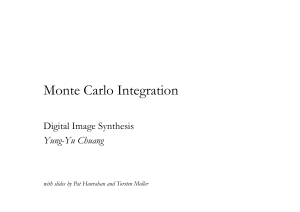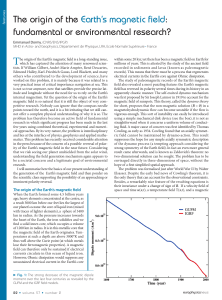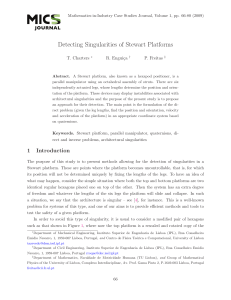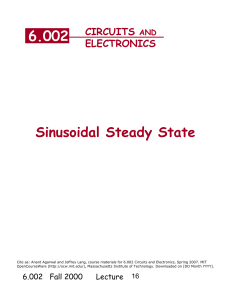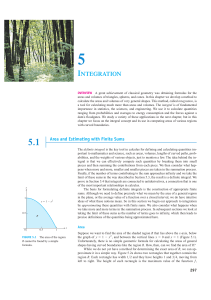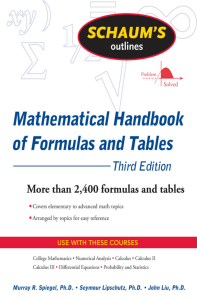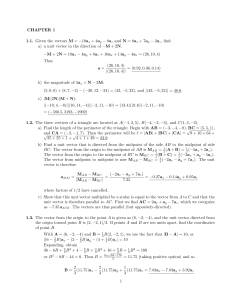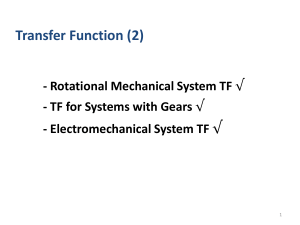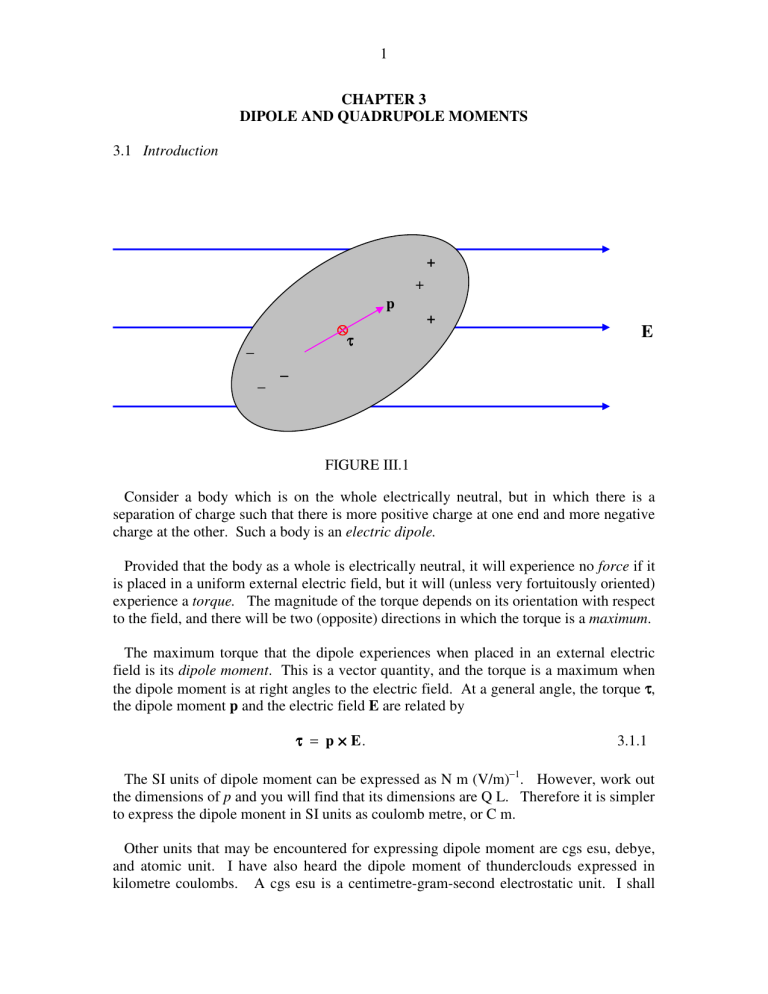
1
CHAPTER 3
DIPOLE AND QUADRUPOLE MOMENTS
3.1 Introduction
+
+
p
1
τ
−
−
+
E
−
FIGURE III.1
Consider a body which is on the whole electrically neutral, but in which there is a
separation of charge such that there is more positive charge at one end and more negative
charge at the other. Such a body is an electric dipole.
Provided that the body as a whole is electrically neutral, it will experience no force if it
is placed in a uniform external electric field, but it will (unless very fortuitously oriented)
experience a torque. The magnitude of the torque depends on its orientation with respect
to the field, and there will be two (opposite) directions in which the torque is a maximum.
The maximum torque that the dipole experiences when placed in an external electric
field is its dipole moment. This is a vector quantity, and the torque is a maximum when
the dipole moment is at right angles to the electric field. At a general angle, the torque τ,
the dipole moment p and the electric field E are related by
τ = p × E.
3.1.1
The SI units of dipole moment can be expressed as N m (V/m)−1. However, work out
the dimensions of p and you will find that its dimensions are Q L. Therefore it is simpler
to express the dipole monent in SI units as coulomb metre, or C m.
Other units that may be encountered for expressing dipole moment are cgs esu, debye,
and atomic unit. I have also heard the dipole moment of thunderclouds expressed in
kilometre coulombs. A cgs esu is a centimetre-gram-second electrostatic unit. I shall
2
describe the cgs esu system in a later chapter; suffice it here to say that a cgs esu of
dipole moment is about 3.336 × 10−12 C m, and a debye (D) is 10−18 cgs esu. An atomic
unit of electric dipole moment is a0e, where a0 is the radius of the first Bohr orbit for
hydrogen and e is the magnitude of the electronic charge. An atomic unit of dipole
moment is about 8.478 × 10−29 C m.
I remark in passing that I have heard, distressingly often, some such remark as “The molecule has a
dipole”. Since this sentence is not English, I do not know what it is intended to mean. It would be English
to say that a molecule is a dipole or that it has a dipole moment.
3.2 Mathematical Definition of Dipole Moment
In the introductory section 3.1 we gave a physical definition of dipole moment. I am
now about to give a mathematical definition.
Q1
r1
r2
Q2
Q3
r3
O•
FIGURE III.2
Consider a set of charges Q1, Q2, Q3 ... whose position vectors with respect to a point O
are r1, r2, r3 ... with respect to some point O. The vector sum
p =
∑Q r
i
i
is the dipole moment of the system of charges with respect to the point O. You can see
immediately that the SI unit has to be C m.
Exercise. Convince yourself that if the system as a whole is electrically neutral, so that
there is as much positive charge as negative charge, the dipole moment so defined is
3
independent of the position of the point O. One can then talk of “the dipole moment of
the system” without adding the rider “with respect to the point O”.
Exercise. Convince yourself that if any electrically neutral system is placed in an
external electric field E, it will experience a torque given by τ = p × E , and so the two
definitions of dipole moment − the physical and the mathematical – are equivalent.
Exercise. While thinking about these two, also convince yourself (from mathematics
or from physics) that the moment of a simple dipole consisting of two charges, +Q and
−Q separated by a distance l is Ql. We have already noted that C m is an acceptable SI
unit for dipole moment.
3.3 Oscillation of a Dipole in an Electric Field
p
•
θ
E
FIGURE III.3
Consider a dipole oscillating in an electric field (figure III.3). When it is at an angle θ
to the field, the magnitude of the restoring torque on it is pE sin θ, and therefore its
equation of motion is I &θ& = − pE sin θ , where I is its rotational inertia. For small angles,
this is approximately I &θ& = − pEθ , and so the period of small oscillations is
P = 2π
I
.
pE
3.3.1
Would you expect the period to be long if the rotational inertia were large? Would you
expect the vibrations to be rapid if p and E were large? Is the above expression
dimensionally correct?
4
3.4 Potential Energy of a Dipole in an Electric Field
Refer again to figure III.3. There is a torque on the dipole of magnitude pE sin θ. In
order to increase θ by δθ you would have to do an amount of work pE sin θ δθ . The
amount of work you would have to do to increase the angle between p and E from 0 to θ
would be the integral of this from 0 to θ, which is pE(1 − cos θ), and this is the potential
energy of the dipole, provided one takes the potential energy to be zero when p and E are
parallel. In many applications, writers find it convenient to take the potential energy
(P.E.) to be zero when p and E perpendicular. In that case, the potential energy is
P.E. = − pE cos θ = − p • E .
3.4.1
This is negative when θ is acute and positive when θ is obtuse. You should verify that
the product of p and E does have the dimensions of energy.
3.5 Force on a Dipole in an Inhomogeneous Electric Field
−Q
δx
+Q
E
FIGURE III.4
Consider a simple dipole consisting of two charges +Q and −Q separated by a distance
δx, so that its dipole moment is p = Q δx. Imagine that it is situated in an inhomogeneous
electrical field as shown in figure III.4. We have already noted that a dipole in a
homogeneous field experiences no net force, but we can see that it does experience a net
force in an inhomogeneous field. Let the field at −Q be E and the field at +Q be
E + δE . The force on −Q is QE to the left, and the force on +Q is Q(E + δE) to the
right. Thus there is a net force to the right of Q δE, or:
Force = p
dE
.
dx
3.5.1
5
Equation 3.5.1 describes the situation where the dipole, the electric field and the
gradient are all parallel to the x-axis. In a more general situation, all three of these are in
different directions. Recall that electric field is minus potential gradient. Potential is a
scalar function, whereas electric field is a vector function with three component, of which
∂V
. Field gradient is a symmetric tensor
the x-component, for example is E x = −
∂x
∂ 2V
∂ 2V
,
,
having nine components (of which, however, only six are distinct), such as
∂x 2 ∂y ∂z
etc. Thus in general equation 3.5.1 would have to be written as
Vxx Vxy Vxz p x
Ex
E
=
−
V
V
V
y
xy
yy
yz p y ,
V V
p
V
xz
yz
zz
Ez
z
3.5.2
in which the double subscripts in the potential gradient tensor denote the second partial
derivatives.
3.6 Induced Dipoles and Polarizability
We noted in section 1.3 that a charged rod will attract an uncharged pith ball, and at that
time we left this as a little unsolved mystery. What happens is that the rod induces a
dipole moment in the uncharged pith ball, and the pith ball, which now has a dipole
moment, is attracted in the inhomogeneous field surrounding the charged rod.
How may a dipole moment be induced in an uncharged body? Well, if the uncharged
body is metallic (as in the gold leaf electroscope), it is quite easy. In a metal, there are
numerous free electrons, not attached to any particular atoms, and they are free to wander
about inside the metal. If a metal is placed in an electric field, the free electrons are
attracted to one end of the metal, leaving an excess of positive charge at the other end.
Thus a dipole moment is induced.
What about a nonmetal, which doesn’t have free electrons unattached to atoms? It may
be that the individual molecules in the material have permanent dipole moments. In that
case, the imposition of an external electric field will exert a torque on the molecules, and
will cause all their dipole moments to line up in the same direction, and thus the bulk
material will acquire a dipole moment. The water molecule, for example, has a
permanent dipole moment, and these dipoles will align in an external field. This is why
pure water has such a large dielectric constant.
But what if the molecules do not have a permanent dipole moment, or what if they do,
but they cannot easily rotate (as may well be the case in a solid material)? The bulk
material can still become polarized, because a dipole moment is induced in the individual
molecules, the electrons inside the molecule tending to be pushed towards one end of the
molecule. Or a molecule such as CH4, which is symmetrical in the absence of an external
6
electric field, may become distorted from its symmetrical shape when placed in an
electric field, and thereby acquire a dipole moment.
Thus, one way or another, the imposition of an electric field may induce a dipole
moment in most materials, whether they are conductors of electricity or not, or whether
or not their molecules have permanent dipole moments.
If two molecules approach each other in a gas, the electrons in one molecule repel the
electrons in the other, so that each molecule induces a dipole moment in the other. The
two molecules then attract each other, because each dipolar molecule finds itself in the
inhomogeneous electric field of the other. This is the origin of the van der Waals forces.
Some bodies (I am thinking about individual molecules in particular, but this is not
necessary) are more easily polarized that others by the imposition of an external field.
The ratio of the induced dipole moment to the applied field is called the polarizability
α of the molecule (or whatever body we have in mind). Thus
p = α E.
3.6.1
The SI unit for α is C m (V m−1) −1 and the dimensions are M−1T2Q2.
This brief account, and the general appearance of equation 3.6.1, suggests that p and E
are in the same direction – but this is so only if the electrical properties of the molecule
are isotropic. Perhaps most molecules – and, especially, long organic molecules − have
anisotropic polarizability. Thus a molecule may be easy to polarize with a field in the xdirection, and much less easy in the y- or z-directions. Thus, in equation 3.6.1, the
polarizability is really a symmetric tensor, p and E are not in general parallel, and the
equation, written out in full, is
α xx α xy α xz E x
px
p y = α xy α yy α yz E y .
α α α E
yz
zz z
pz
xz
3.6.2
(Unlike in equation 3.5.2, the double subscripts are not intended to indicate second partial
derivatives; rather they are just the components of the polarizability tensor.) As in
several analogous situations in various branches of physics (see, for example, section
2.17 of Classical Mechanics and the inertia tensor) there are three mutually orthogonal
directions (the eigenvectors of the polarizability tensor) for which p and E will be
parallel.
7
3.7
The Simple Dipole
As you may expect from the title of this section, this will be the most difficult and
complicated section of this chapter so far. Our aim will be to calculate the field and
potential surrounding a simple dipole.
A simple dipole is a system consisting of two charges, +Q and −Q, separated by a
distance 2L. The dipole moment of this system is just p = 2QL. We’ll suppose that the
dipole lies along the x-axis, with the negative charge at x = −L and the positive charge at
x = +L . See figure III.5.
E1
θ
θ
P
E2
y
−Q
L
L
+Q
FIGURE III.5
Let us first calculate the electric field at a point P at a distance y along the y-axis. It
will be agreed, I think, that it is directed towards the left and is equal to
Q
L
.
E1 cos θ + E2 cos θ , where E1 = E2 =
and cos θ = 2
2
2
4πε 0 ( L + y )
( L + y 2 )1/ 2
Therefore
E =
For large y this becomes
2QL
p
.
=
2
2 3/ 2
2
4πε 0 ( L + y )
4πε 0 ( L + y 2 ) 3 / 2
3.7.1
8
E =
p
.
4πε 0 y 3
3.7.2
That is, the field falls off as the cube of the distance.
To find the field on the x-axis, refer to figure III.6.
x
−Q
L
E2
+Q
•
E1
•
L
P
FIGURE III.6
It will be agreed, I think, that the field is directed towards the right and is equal to
Q
1
1
.
E = E1 − E2 =
−
3.7.3
2
2
4πε 0 ( x − L)
( x + L)
, and on expansion of this by
2
the binomial theorem, neglecting terms of order ( L / x) and smaller, we see that at large
x the field is
2p
.
3.7.4
E =
4πε 0 x 3
Now for the field at a point P that is neither on the axis (x-axis) nor the equator (y-axis) of
the dipole. See figure III.7.
This can be written
Q
1
1
−
2
2
4πε 0 x (1 − L / x)
(1 + L / x) 2
•P
r2
r1
r
−Q
θ
L
L
FIGURE III.7
+Q
φ
(x , y)
9
It will probably be agreed that it would not be particularly difficult to write down
expressions for the contributions to the field at P from each of the two charges in turn.
The difficult part then begins; the two contributions to the field are in different and
awkward directions, and adding them vectorially is going to be a bit of a headache.
It is much easier to calculate the potential at P, since the two contributions to the
potential can be added as scalars. Then we can find the x- and y-components of the field
by calculating ∂V / ∂x and ∂V / ∂y .
Thus
V =
Q
1
1
.
−
2
2 1/ 2
2
2 1/ 2
4πε 0 {( x − L) + y }
{( x + L) + y }
3.7.5
To start with I am going to investigate the potential and the field at a large distance
from the dipole – though I shall return later to the near vicinity of it.
At large distances from a small dipole (see figure III.8), we can write r 2 = x 2 + y 2 ,
P(x , y)
r
θ
FIGURE III.8
and, with L2 << r2, the expression 3.7.5 for the potential at P becomes
V =
Q
1
1
Q
2
=
− 2
(1 − 2 Lx / r 2 ) −1/ 2 − (1 + 2 Lx / r 2 ) −1/ 2 .
1/ 2
1/ 2
4πε 0 (r − 2 Lx)
(r + 2 Lx)
4πε 0 r
(
)
10
When this is expanded by the binomial theorem we find, to order L/r , that the potential
can be written in any of the follwing equivalent ways:
V =
px
p cos θ
p•r .
2QLx
=
=
=
3
3
2
4πε 0 r
4πε 0 r
4πε 0 r
4πε 0 r 3
3.7.6
Thus the equipotentials are of the form
r 2 = c cos θ ,
3.7.7
p .
4πε 0V
3.7.8
c =
where
Now, bearing in mind that r 2 = x 2 + y 2 , we can differentiate V =
px
with
4πε 0 r 3
respect to x and y to find the x- and y-components of the field.
Thus we find that
Ex =
p 3x 2 − r 2
pxy
.
and E y =
5
5
4πε 0
r
4
πε
r
0
3.7.9a,b
We can also use polar coordinates find the radial and transverse components from
p cos θ
∂V
1 ∂V
Er = −
and Eθ = −
together with V =
to obtain
r ∂θ
4πε 0 r 2
∂r
Er =
2 p cos θ
p sin θ
.
and Eθ =
3
4πε 0 r
4πε 0 r 3
For those who enjoy vector calculus, we can also say E = −
3.7.10a,b
1
p•r
∇ 3 , from which,
4πε 0 r
after a little algebra and quite a lot of vector calculus, we find
E =
1 3(p • r ) r
p
− 3.
5
4πε 0 r
r
3.7.11
This equation contains all the information that we are likely to want, but I expect most
readers will prefer the more explicit rectangular and polar forms of equations 3.7.9 and
3.7.10.
11
Equation 3.7.7 gives the equation to the equipotentials. The equation to the lines of force
can be found as follows. Referring to figure III.9, we see that the differential equation to
the lines of force is
dr
FIGURE III.9
r dθ
Eθ
E
Er
dθ
r
dθ
E
sin θ
= θ =
=
dr
Er
2 cos θ
1
2
tan θ ,
3.7.12
which, upon integration, becomes
r = a sin 2 θ .
3.7.13
Note that the equations r 2 = c cos θ (for the equipotentials) and r = a sin 2 θ (for the
lines of force) are orthogonal trajectories, and either can be derived from the other. Thus,
dθ
given that the differential equation to the lines of force is r
= 12 tan θ with solution
dr
r = a sin 2 θ , the differential equation to the orthogonal trajectories (i.e. the
1 dr
equipotentials) is −
= 12 tan θ , with solution r 2 = c cos θ .
r dθ
In figure III.10, there is supposed to be a tiny dipole situated at the origin. The unit of
length is L, half the length of the dipole. I have drawn eight electric field lines
(continuous), corresponding to a = 25, 50, 100, 200, 400, 800, 1600, 3200. If r is
Q ,
expressed in units of L, and if V is expressed in units of
the equations 3.7.7 and
4πε 0 L
12
2 cos θ
, and I have drawn seven
V
equipotentials (dashed) for V = 0.0001, 0.0002, 0.0004, 0.0008, 0.0016, 0.0032,
0.0064. It will be noticed from equation 3.7.9a, and is also evident from figure III.10,
that Ex is zero for θ = 54 o 44' .
3.7.8 for the equipotentials can be written r =
FIGURE III.10
100
V = 0.0001
90
80
70
V = 0.0002
y/L
60
50
a = 200
40
a = 400
30
20
10
0
0
20
40
60
80
100
x/L
At the end of this chapter I append a (geophysical) exercise in the geometry of the field
at a large distance from a small dipole.
Equipotentials near to the dipole
These, then, are the field lines and equipotentials at a large distance from the dipole.
We arrived at these equations and graphs by expanding equation 3.7.5 binomially, and
neglecting terms of higher order than L/r. We now look near to the dipole, where we
cannot make such an approximation. Refer to figure III.7.
We can write 3.7.5 as
13
V ( x , y) =
Q 1
1
,
−
r2
4πε 0 r1
3.7.14
where r12 = ( x − L) 2 + y 2 and r22 = ( x + L) 2 + y 2 .
If, as before, we express
Q ,
distances in terms of L and V in units of
the expression for the potential becomes
4πε 0 L
V ( x , y) =
1
1
−
,
r1
r2
3.7.15
where r12 = ( x + 1) 2 + y 2 and r22 = ( x − 1) 2 + y 2 .
One way to plot the equipotentials would be to calculate V for a whole grid of (x , y)
values and then use a contour plotting routine to draw the equipotentials. My computing
skills are not up to this, so I’m going to see if we can find some way of plotting the
equipotentials directly.
I present two methods. In the first method I use equation 3.7.15 and endeavour to
manipulate it so that I can calculate y as a function of x and V. The second method was
shown to me by J. Visvanathan of Chennai, India. We’ll do both, and then compare
them.
First Method.
To anticipate, we are going to need the following:
r12 r22 = ( x 2 + y 2 + 1) 2 − 4 x 2 = B 2 − A,
3.7.16
r12 + r22 = 2( x 2 + y 2 + 1) = 2 B,
3.7.17
and
r14 + r24 = 2[( x 2 + y 2 + 1) 2 + 4 x 2 ] = 2( B 2 + A),
3.7.18
where
A = 4x 2
3.7.19
and
B = x 2 + y 2 + 1.
3.7.20
Now equation 3.7.15 is r1r2V = r2 − r1 . In order to extract y it is necessary to square
this twice, so that r1 and r2 appear only as r12 and r22 . After some algebra, we obtain
r12 r22 [2 − V 4 r12 r22 + 2V 2 (r12 + r22 )] = r14 + r24 .
3.7.21
14
Upon substitution of equations 3.7.16,17,18, for which we are well prepared, we find
for the equation to the equipotentials an equation which, after some algebra, can be
written as a quartic equation in B:
where
and
a0 + a1 B + a2 B 2 + a3 B 3 + a4 B 4 = 0 ,
3.7.22
a0 = A(4 + V 4 A) ,
3.7.23
a1 = 4V 2 A ,
3.7.24
a2 = − 2V 2 A ,
3.7.25
a3 = − 4V 2 ,
3.7.26
a4 = V 4 .
3.7.27
The algorithm will be as follows: For a given V and x, calculate the quartic coefficients
from equations 3.7.23-27. Solve the quartic equation 3.7.22 for B. Calculate y from
equation 3.7.20. My attempt to do this is shown in figure III.11. The dipole is supposed
to have a negative charge at (−1 , 0) and a positive charge at (+1 , 0). The equipotentials
are drawn for V = 0.05, 0.10, 0.20, 0.40, 0.80.
15
FIGURE III.11
4
3.5
V = 0.05
3
y/L
2.5
V = 0.10
2
1.5
V = 0.20
1
V = 0.40
0.5
0
V = 0.80
0
1
2
3
x/L
4
5
6
Second method (J. Visvanathan).
In this method, we work in polar coordinates, but instead of using the coordinates
(r , θ) , in which the origin, or pole, of the polar coordinate system is at the centre of the
dipole (see figure III.7), we use the coordinates (r1 , φ) with origin at the positive charge.
From the triangle, we see that
r22 = r12 + 4 L2 + 4 Lr1 cos φ.
3.7.28
For future reference we note that
∂r2
r + 2 L cos φ
.
= 1
r2
∂r1
3.7.29
Provided that distances are expressed in units of L, these equations become
r22 = r12 + 4r1 cos φ + 4 ,
3.7.30
16
∂r2
r + 2 cos φ
= 1
.
r2
∂r1
If, in addition, electrical potential is expressed in units of
3.7.31
Q
, the potential at P is
4πε 0 L
given, as before (equation 3.17.15), by
V (r1 , φ) =
1
1
−
.
r1
r2
3.7.32
Recall that r2 is given by equation 3.7.30, so that equation 3.7.32 is really an equation in
just V, r1 and φ.
In order to plot an equipotential, we fix some value of V; then we vary φ from 0 to π,
and, for each value of φ we have to try to calculate r1.This can be done by the NewtonRaphson process, in which we make a guess at r1 and use the Newton-Raphson process to
obtain a better guess, and continue until successive guesses converge. It is best if we can
make a fairly good first guess, but the Newton-Raphson process will often converge very
rapidly even for a poor first guess.
Thus we have to solve the following equation for r1 for given values of V and φ,
f (r1 ) =
1
1
−
− V = 0,
r1
r2
3.7.33
bearing in mind that r2 is given by equation 3.7.31.
By differentiation with respect to r1, we have
f ' (r1 ) = −
1
1 ∂r
1
r + 2 cos φ
+ 2 2 = − 2 + 1
,
2
r1
r2 ∂r1
r1
r23
3.7.34
and we are all set to begin a Newton-Raphson iteration: r1 = r1 − f / f '. Having
obained r1, we can then obtain the ( x, y ) coordinates from x = 1 + r1 cos φ and
y = r1 sin φ .
I tried this method and I got exactly the same result as by the first method and as shown
in figure III.11.
So which method do we prefer? Well, anyone who has worked through in detail the
derivations of equations 3.7.16 -3.7.27, and has then tried to program them for a
computer, will agree that the first method is very laborious and cumbersome. By
comparison Visvanathan’s method is much easier both to derive and to program. On the
17
other hand, one small point in favour of the first method is that it involves no
trigonometric functions, and so the numerical computation is potentially faster than the
second method in which a trigonometric function is calculated at each iteration of the
Newton-Raphson process. In truth, though, a modern computer will perform the
calculation by either method apparently instantaneously, so that small advantage is hardly
relevant.
So far, we have managed to draw the equipotentials near to the dipole. The lines of
force are orthogonal to the equipotentials. After I tried several methods with only partial
success, I am grateful to Dr Visvanathan who pointed out to me what ought to have been
the “obvious” method, namely to use equation 3.7.12, which, in our (r1 , φ) coordinate
Eφ
dφ
system based on the positive charge, is r1
=
, just as we did for the large
dr1
Er1
distance, small dipole, approximation. In this case, the potential is given by equations
3.7.30 and 3.7.32. (Recall that in these equations, distances are expressed in units of L
Q
and the potential in units of
.) The radial and transverse components of the field
4πε 0 L
∂V
1 ∂V
are given by Er1 = −
and Eφ = −
, which result in
∂r1
r1 ∂φ
Er1 =
1
r + 2 cos φ
− 1
2
r1
r23
3.7.35
2 sin φ
.
r23
3.7.36
Eφ =
and
Q
, although that hardly matters, since we
4πε 0 L2
Eφ
dφ
are interested only in the ratio. On applying r1
=
to these field components we
dr1
Er1
Here, the field is expressed in units of
obtain the following differential equation to the lines of force:
dφ =
(r12
2r1 sin φ
dr1.
+ 4 + 4r1 cos φ)3 / 2 − r12 (r1 + 2 cos φ)
3.7.37
Thus one can start with some initial φ0 and small r2 and increase r1 successively by small
increments, calculating a new φ each time. The results are shown in figure III.12, in
which the equipotentials are drawn for the same values as in figure III.11, and the initial
angles for the lines of force are 30º, 60º, 90º, 120º, 150º.
18
FIGURE III.12
4
3.5
3
y/L
2.5
2
1.5
1
0.5
0
0
1
2
3
x/L
4
5
6
3.8 Quadrupole Moment
−Q
+Q
+Q
−Q
FIGURE III.13
Consider the system of charges shown in figure III.13. It has no net charge and no net
dipole moment. Unlike a dipole, it will experience neither a net force nor a net torque in
any uniform field. It may or may not experience a net force in an external nonuniform
field. For example, if we think of the quadrupole as two dipoles, each dipole will
experience a force proportional to the local field gradient in which it finds itself. If the
field gradients at the location of each dipole are equal, the forces on each dipole will be
equal but opposite, and there will net force on the quadrupole. If, however, the field
19
gradients at the positions of the two dipoles are unequal, the forces on the two dipole will
be unequal, and there will be a net force on the quadruople. Thus there will be a net force
if there is a non-zero gradient of the field gradient. Stated another way, there will be no
net force on the quadrupole if the mixed second partial derivatives of the field componets
(the third derivatives of the potential!) are zero. Further, if the quadrupole is in a
nonuniform field, increasing, say, to the right, the upper pair will experience a force to
the right and the lower pair will experience a force to the left; thus the system will
experience a net torque in an inhomogeneous field, though there will be not net force
unless the field gradients on the two pairs are unequal.
The system possesses what is known as a quadrupole moment. While a single charge is
a scalar quantity, and a dipole moment is a vector quantity, the quadrupole moment is a
second order symmetric tensor.
The dipole moment of a system of charges is a vector with three components given by
p x = ∑ Qi xi , p y = ∑ Qi yi , p z = ∑ Qi zi . The quadrupole moment q has nine
components (of which six are distinct) defined by q xx =
and its matrix representation is
q xx q xy q xz
q = q xy q yy q yz .
q q q
xz
yz
zz
∑Q x
2
i i
, q xy =
∑Q x y
i i
i
, etc.,
3.8.1
For a continuous charge distribution with charge density ρ coulombs per square metre,
the components will be given by q xx = ∫ ρ x 2 dτ , etc., where dτ is a volume element,
given in rectangular coordinates by dxdydz and in spherical coordinates by
r 2 sin θ drdθdφ . The SI unit of quadrupole moment is C m2, and the dimensions are L2Q,
By suitable rotation of axes, in the usual way (see for example section 2.17 of Classical
Mechanics), the matrix can be diagonalized, and the diagonal elements are then the
eigenvalues of the quadrupole moment, and the trace of the matrix is unaltered by the
rotation.
3.9
Potential at a Large Distance from a Charged Body
We wish to find the potential at a point P at a large distance R from a charged body, in
terms of its total charge and its dipole, quadrupole, and possibly higher-order moments.
There will be no loss of generality if we choose a set of axes such that P is on the z-axis.
20
We refer to figure III.14, and we consider a volume element δτ at a distance r from some
origin. The point P is at a distance r from the origin and a distance ∆ from δτ. The
potential at P from the charge in the element δτ is given by
P
∆
δτ
FIGURE III.14
R
r
z
θ
O
ρ δτ
ρ
r2
2r
1 + 2 −
4πε 0 δ V =
=
cos θ
∆
R
R
R
−1 / 2
δτ ,
3.9.1
and so the potential from the charge on the whole body is given by
1
r2
2r
4πε 0 V =
ρ
1
+
−
cos
θ
R ∫
R2
R
−1 / 2
δτ .
3.9.2
On expanding the parentheses by the binomial theorem, we find, after a little trouble, that
this becomes
4πε 0 V =
1
1
1
ρ dτ + 2 ∫ ρ r P1 (cos θ) dτ +
ρ r 2 P2 (cos θ) dτ
∫
R
R
2! R 3 ∫
1
+
ρ r 3 P3 (cos θ) dτ + K ,
4 ∫
3! R
3.9.3
where the polynomials P are the Legendre polynomials given by
P1 (cos θ) = cos θ ,
3.9.4
P2 (cos θ) = 12 (3 cos 2 θ − 1) ,
3.9.5
21
P3 (cos θ) = 12 (5 cos 3 θ − 3 cos θ) .
and
3.9.6
We see from the forms of these integrals and the definitions of the components of the
dipole and quadrupole moments that this can now be written:
4πε 0V =
Q
p
1
+ 2 +
(3q zz − Tr q) + K ,
R
R
2R3
3.9.7
Here Tr q is the trace of the quadrupole moment matrix, or the (invariant) sum of its
diagonal elements. Equation 3.9.7 can also be written
4πε 0V =
Q
p
1
+ 2 +
[2q zz − (q xx + q yy )] + K .
R
R
2R3
3.9.8
The quantity 2q zz − (q xx + q yy ) of the diagonalized matrix is often referred to as “the”
quadrupole moment.
It is zero if all three diagonal components are zero or if
1
q zz = 2 (q xx + q yy ) . If the body has cylindrical symmetry about the z-axis, this becomes
2(q zz − q xx ) .
Exercise.
Show that the potential at (r , θ) at a large distance from the linear quadrupole of figure
III.15 is
QL2 (3 cos 2 θ − 1) .
4πε 0 r 3
(The gap in the dashed line is intended to indicate that r is very large compared with L.)
V =
•
r
+Q
L
−2Q
θ
L
+Q
FIGURE III.15
The solution to this exercise is easy if you know about Legendre polynomials. See
Section 1.14 of my notes on Celestial Mechanics. What you need to know is that the
22
expansion of (1 − 2ax + x 2 ) −1 / 2 can be written as a series of Legendre polynomials,
namely P0 ( x) + xP1 ( x) + x 2 P2 ( x) + ... . You also need a (very small) table of
Legendre polynamials, namely P0 ( x) = 1, P1 ( x) = x, P2 ( x) =
that, you should find the exercise very easy.
1
2
(3 x 2 − 1). Given
3.10 A Geophysical Example
Assume that planet Earth is spherical and that it has a little magnet or current loop at
its centre. By “little” I mean small compared with the radius of the Earth. Suppose that,
at a large distance from the magnet or current loop the geometry of the magnetic field is
the same as that of an electric field at a large distance from a simple dipole. That is to
say, the equation to the lines of force is r = a sin 2 θ (equation 3.7.13), and the
dr
2r
(equation 3.7.12).
differential equation to the lines of force is
=
dθ
tan θ
Show that the angle of dip D at geomagnetic latitude L is given by
tan D = 2 tan L.
3.10.1
The geometry is shown in figure III.16.
The result is a simple one, and there is probably a simpler way of getting it than the one
I tried. Let me know ([email protected]) if you find a simpler way. In the meantime, here
is my solution.
I am going to try to find the slope m1 of the tangent to Earth (i.e. of the horizon) and
the slope m2 of the line of force. Then the angle D between them will be given by the
equation (which I am hoping is well known from coordinate geometry!)
tan D =
m1 − m2
.
1 + m1m2
3.10.2
The first is easy:
m1 = tan(90o + θ) = −
1
.
tan θ
3.10.3
For m2 we want to find the slope of the line of force, whose equation is given in polar
coordinates? So, how do you find the slope of a curve whose equation is given in polar
coordinates? We can do it like this:
23
x = r cos θ,
y = r sin θ,
dx = cos θdr − r sin θdθ,
dy = sin θdr + r cos θdθ.
3.10.4
3.10.5
3.10.6
3.10.7
From these, we obtain
sin θ ddrθ + r cos θ
dy
=
.
cos θ ddrθ − r sin θ
dx
3.10.8
dr
2r
=
(equation 3.7.12), so if we substitute this
dθ
tan θ
into equation 3.10.8 we soon obtain
In our particular case, we have
m2 =
3 sin θ cos θ
.
3 cos 2 θ − 1
3.10.9
Now put equations 3.10.3 and 3.10.9 into equation 3.10.2, and, after a little algebra, we
soon obtain
tan D =
2
= 2 tan L.
tan θ
3.10.10
24
y
D m2
m1
L
θ
South
x
North
Equator
Here is another question. The magnetic field is generally given the symbol B. Show that
the strength of the magnetic field B (L) at geomagnetic latitude L is given by
B ( L) = B (0) 1 + 3 sin 2 L ,
3.10.11
25
where B (0) is the strength of the field at the equator. This means that it is twice as strong
at the magnetic poles as at the equator.
Start with equation 3.7.2, which gives the electric field at a distant point on the equator
p
. In this case we are dealing with
of an electric dipole. That equation was E =
4πε 0 y 3
a magnetic field and a magnetic diople, so we’ll replace the electric field E with a
magnetic field B. Also p /(4πε 0 ) is a combination of electrical quantities, and since we
are interested only in the geometry (i.e. on how B varies from equation to pole, let’s just
write p /(4πε 0 ) as k. And we’ll take the radius of Earth to be R, so that equation 3.7.2
gives for the magnetic field at the surface of Earth on the equator as
B ( 0) =
k
.
R3
3.10.12
In a similar vein, equations 3.7.10a,b for the radial and transverse components of the field
at geomagnetic latitude L (which is 90º − θ) become
Br ( L) =
And since B =
2k sin L
k cos L
.
and
B
(
L
)
=
θ
R3
R3
Br2 + Bθ2 , the result immediately follows.
3.10.13a,b
